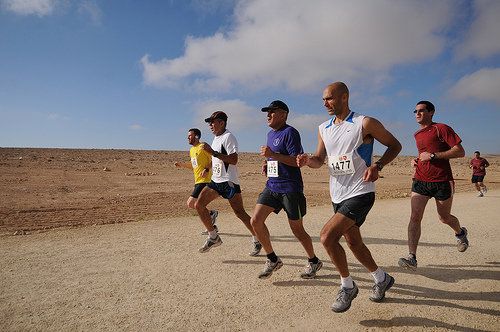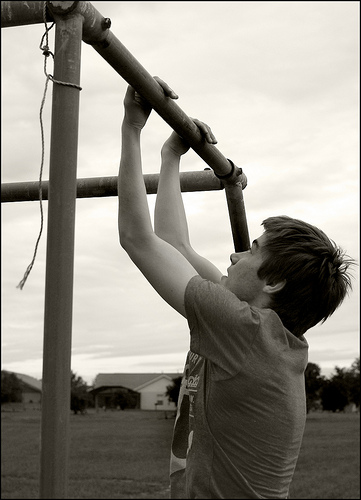Despite popular belief, there is a key difference between simply working out and training; a goal, a workout regime and a program that follows the principles of training. Toby Cryne explains the key training rules that have helped him through marathons, triathlons and Muay Thai fights over the past few years.
The Fundamental Principles of Training to Improve Performance
The principles of training are a fundamental set of rules in order to improve sports performance and are often overlooked by beginners. I first came across these rules about five years into my development as an athlete (I use the term athlete sparingly). Yet, no sooner had I started to understand these basics, my performance increased massively, my times improved and my training seemed less like work. Sure, not everyone wants to train. Some people workout for mental relief, some for social time and many just to get away from the kids for an hour. But for those that want to improve their marathon times, build bigger muscles or lose weight these rules can be applied to any training regime to reap massive benefits in a short amount of time.
For those new to this concept, the acronym SPORT is probably the easiest way to remember how to construct a training plan regardless of the nature of the goal.[1]

Specificity: Itֳ pointless deadlifting 100ֳ of kilos if you want to improve your marathon time much like itֳ pointless running 100miles per week if you want to create Herculean muscle. Being specific to your sport is one of the most important factors in developing performance. Being specific doesnִ mean that you have to ditch everything you love entirely however as many runners can benefit from light resistance training and many strength athletes can benefit from cardiovascular exercise. Focused training should be tailored to the goal in mind that is within the parameters of the athlete.
Progression: A key concern with beginners is that they try and do far too much for their capabilities thinking that more hours equate to more success. This is simply not true, especially in the blurry world of weight loss. Though a three hour run may create a substantial calorie deficit, the recovery needed following such a run will often throw those not capable of such distances off the rails causing them to miss out on training for a period of time. Simply, there is no point blasting out a three hour run if it takes you a week to recover. A far more manageable goal would be to try to achieve 45 minutes five times a week which over the course of that week would equate to three hours and 45 minutes of exercise. When a manageable goal such as this has been achieved comfortably, improving each workout by a small fraction in a progressive manner will reap far greater rewards, decrease the chance of injury and reduce the impact on the joints. The same can be said for weight training. By adding weight in small increments over a longer period of time, the body will adapt and recover to the stimuli without the huge amounts of stress placed on the muscles and adrenal system during heavy weightlifting. Sir Dave Brailsford of TeamSky cycling team calls it marginal gains, a process of progression that the team apply to everything; the athlete, the technology, the bike, the nutrition. The idea is that by improving each aspect by a small percentage, the whole performance will increase massively.[2]

Overload: This concept ties nicely to progression. As the body is a clever set of organisms, once a stimulus has been dealt with and the appropriate action has been taken place (e.g. the muscles building back stronger after a particular strength workout), it needs to be pushed again in order to improve again. By working just outside of the comfort zone, the body will be forced to adapt to the demands of the exercise. If you can run comfortably for 60 minutes, running for 65 minutes will push the body to adapt and develop. The concept of overload is exceptionally useful in muscle building as the development of muscle fiber is directly linked to the stresses placed on it. If one lifts just a few kilograms heavier than they are comfortable with and progresses as they adapt, that muscle will be forced to grow repeatedly.[3]
Rest: In contrast to popular belief, in exercise more is not always more. In fact, it is at times of rest when the body actually adapts to the specifics of the training being undertaken. On both a physical and psychological level, rest will allow your body to recover from the exercises which you are putting it through. On a cellular level, resting time is when the most improvements take place with muscle tissue rebuilding and developing to better to cope with the demands of the exercises being undertaken.[4] But that doesnִ mean that one must sleep for hours following a strenuous workout either. Active recovery can be just as important as complete rest during high intensity training such as when in the final weeks of marathon training. Active recovery involves some form of exercise to get blood flowing around the body and promotes the oxygenating of working muscles. Common active recovery sessions include swimming, cycling and walking as these are low/zero impact on the musculoskeletal system.
Time: All of the above principles are pretty much meaningless without a correct time frame. A severely overweight person would not be wise to engage in intense marathon training as this can be problematic to the joints and respiratory system. Instead, choosing a correct time frame that benefits you as an athlete, fits around your work and family life and is feasible will ensure that you reach your goals without injuries or set-backs.
To better understand the principles of training check out Dr Frank Dickֳ best seller Sports Training Principles and let us know how you get on!
Twitter: tobythechimp
[1] http://www.brianmac.co.uk/trnprin.htm
[2] http://jamesclear.com/marginal-gains
[3] http://www.humankinetics.com/excerpts/excerpts/training-principles-to-improve-athlete-performance
[4] http://sportsmedicine.about.com/od/sampleworkouts/a/RestandRecovery.htm


